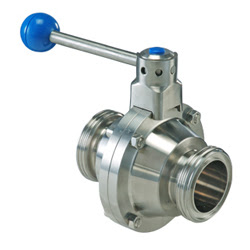Classification of Ball Valves by Their Structural Types
Classification of Ball Valves by Their Structural Types
Floating ball valve
The sphere of the ball valve floats. Under the effect of medium pressure, the sphere can produce a certain displacement and be pressed tight on the sealing surface at the outlet, ensuring the sealing of the outlet.
The floating ball valve has a simple structure and good sealing, but a load of working medium sustained by the sphere is all passed on to the outlet sealing ring. Therefore, one needs to consider if the material of the sealing ring can sustain the working load of the sphere medium. This structure is widely used in medium and low-pressure ball valves.
Fixed ball valve
The sphere of the ball valve is fixed and doesn’t move after being pressured. All fixed ball valves have floating valve seats. Under medium pressure, the valve seat moves, pressing the sealing ring tight on the sphere to ensure sealing. Usually, bearings are installed on the upper and lower shafts of the sphere. It has a small operating torque and is suitable for valves of high pressure and large diameter.
In order to reduce the operating torque of the ball valve and to increase the reliability of the sealing, there have been oil sealing ball valves in recent years. Special lubricants are injected between the sealing surfaces to form a layer of oil film, which not only enhances the sealing but also reduces the operating torque. It is more suitable for ball valves of high pressure and large diameter.
The sphere of the ball valve is elastic:
The sphere and the sealing ring of the valve seat are both made of metals. The sealing pressure is very large. Relying on the pressure of the medium itself already can’t meet the requirements of sealing, so external forces must be applied. This type of valve is suitable for the medium of high temperature and high pressure.
There is an elastic groove at the lower end of the inner wall of the sphere. When closing the channel, use the wedge of the valve stem to keep the sphere ballooned and pressed tight against the valve seat to achieve sealing. Loosen the wedge head before turning the sphere, and the sphere restores its original shape so that there is a very small gap between the sphere and the valve seat, which can reduce the friction of the sealing surface and the operating torque.
According to its channel positions, the sanitary ball valve can be divided into straight-through, three-way, and right angle types. Three-way and right-angle ball valves are used to dispense the medium and change the flow direction of the medium.
• 3-Way Type-Y Ball Valve Configuration and Features
• Major ApplicationsType-Y ball valves are ideally suited for use with fluids containing powders. Slurry or other highly we-inducing fluids and highly viscous fluids, or for cleaning the interior of pipes including valves, or to allow the passage of pigs or spheres in order to avoid contamination from (mixing of) different fluid types.
• Features
O Wide Angle Body Shape
Whereas ordinary 3-way ball valves have a bending angle of 90 type valves have a wide bending angle of 135’ to enable the passage of pigs or spheres to clean the pipe interior.
OSelectable Mounting Position
Two types of the flange are available: a straight flange and one with a 225 bend. These two types of the flange can be mounted at any three locations to enable various mounting patterns.




Comments
Post a Comment